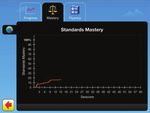How is My Child Doing in ST Math? - MIND Research Institute
←
→
Page content transcription
If your browser does not render page correctly, please read the page content below
How is My Child Doing
in ST Math?
www.stmath.com
1 4
After your child logs in to ST Math, click on (Optional) If your school has access to Fluency,
the graph icon at the bottom of the screen. click on the Fluency tab to see the Mastery
This shows Overall Progress, Standards score. Don’t worry; it takes several introductory
Mastery, and Fluency Mastery (if available). sessions before fact mastery begins.
Children should work for 100% mastery.
2
5
The globe represents the Overall Progress
through the entire curriculum. This graphs the Progress can be viewed for past objectives
percent complete and the number of sessions. by clicking on the cone icon at the bottom
of the screen.
3
6
www.stmath.com
Click on the Mastery tab above the graph to see
the Standards Mastery score. This is based on Choose the objective.
the post-quiz scores and completion rates.7 9
Click on the graph icon. Select the bar graph icon at the bottom of the
screen to see your child’s pre- and post-quiz
scores. The thinner bars show how confident
8 your child was about the answers given.
10
The cone tab with the line graph icon shows
the rate of progress through the objective.
Select the table icon at the bottom of the
screen to see an item analysis for the quiz.
This shows which items were missed and
how confident your child felt for each
question on both quizzes.
So what can you do with this information?
• Most importantly, encourage your child and focus on successes.
• Open a completed objective with your child. Open up some games. Ask your child to play the games and
to tell you how they are “winning”. Listen for their thinking processes.
• Go over the data with your child. While quizzes can’t be viewed or retaken, low scores mean your child
would probably benefit from replaying the games in that objective. Ask which games were most
challenging. Replay these games.
• Encourage your child to take time and put in effort when taking the quizzes.
• Look for learning trends when looking at objective progress. A steep line indicates the student moved
quickly through the games, while a more flat line indicates the student may have struggled.
© 2017 MIND Research Institute. All rights reserved. ED-PT-110-1800208Facilitating Questions
In ST Math®
then get more challenging as the student
progresses. When they reach a challenging
problem, they may ask for your help.
To help them, ask questions like:
What do you notice about the puzzle?
What can you click?
What can you do to get JiJi across the screen?
What question is this puzzle asking?
Describe the strategy that you are going to use.
Describe what you see after you click.
What did you learn?
What will you do now?
What do you expect to see?
What did you learn from the previous level that
can help you here?
© 2018 MIND Research Institute. All rights reserved.
www.stmath.comBring Math Into Your Family Routine
Reading with your child is considered
an integral part of a daily or nightly routine.
But shouldn't math also be equally important?
www.stmath.com
We don't mean doing worksheets of problems with your child. Instead, think about how
you can incorporate mathematical conversation into daily activities like cooking, shopping,
driving, or combine them with other activities like games, art and puzzles.
You can use ST Math to promote mathematical conversation with one of these ideas
below:
l Ask your child to select a level they have completed (it will be marked in green),
and teach it to a family member.
l Build a summer math word wall with vocabulary words they use while explaining
the games.
l Create word problems that go along with each puzzle.
l Write a math story based on the visual picture in a level.
For more ideas on how to bring math into your family's routine, check out these resources:
K-12 Game-a-thon (mindresearch.org/gameathon) - Design a math game with your child
and enter it in this national challenge!
Bedtime Math App (bedtimemath.org/apps/) - Daily activities and problems to solve together.
Calculation Nation (calculationnation.nctm.org) - Interactive games for upper elementary
and middle grades math curriculum with fractions, factors, multiples, and more.
The California Math Council (cmc-math.org/about) - Free math education articles and
activities for students from pre-K through high school.
Figure This! (figurethis.nctm.org) - Math challenges for middle school students and families.
The Math Forum (mathforum.org/) - “Ask Dr. Math”, take on an internet math hunt, or
compete in one of the many weekly and monthly math challenges based on grade level.
Illustrative Mathematics (illustrativemathematics.org) - Mathematical tasks that closely
illustrate all of the Common Core Standards for each grade.
www.stmath.com
© 2018 MIND Research Institute. All rights reserved.Homework Without Tears:
12 Homework Tips for Parents
You don't have to dread helping your kids
with math homework.
www.stmath.com
Homework helps students develop study skills, fosters independence and responsibility, increases
students’ understanding of content, teaches time management skills and builds positive academic
self-image. Unfortunately homework can also cause unnecessary frustration, prevent students from
participating in extracurricular activities and lead to poor self-esteem.
Luckily those negative aspects are preventable by making homework an important priority for your
family and trying out these 12 helpful homework tips:
1. Limit Distractions. Create a homework zone for your students that is away from the T.V. and
other places where there could be distractions such as pets, people coming and going and loud
noises.
2. Provide Tools. Make sure the materials your student may need are readily available. It’s
helpful to have a stash of pencils, pens, a dictionary, etc. available. Check in regularly and make
sure that any special materials needed for class projects are provided so their work won’t be
disturbed.
3. Help Manage Time. Establish a set time for doing homework. Don’t wait until just before
bedtime to do homework when students are tired and easily distracted. Think about using a
weekend morning or afternoon for working on big projects, especially if the project involves
getting together with other classmates.
4. Be Positive. The attitude you express toward homework will be the same attitude your child
acquires. Make it a habit to tell your child that the work they’re doing is important.
5. Do YOUR Homework Too. Show that the skills they’re learning are related to things you
also do as an adult. If your student is reading, you could be reading too. If your student is
practicing math, you could balance your checkbook.
6. Teach Don’t Tell. It’s important that when asked for help you give guidance but not
answers, that way your student learns the material and concepts. Remember that a lot can be
learned from struggle and that too much help can teach your child that when the going gets
rough, someone will do the work for them.
www.stmath.com7. Cooperate. Teachers will often ask that you play a role in your child’s homework. Make sure
you’re being an advocate for the teacher and follow their direction so you can show that school
and home are a team.
8. Foster Independence. Some homework is really intended for students to do alone.
Homework is a great way for kids to develop independence and accountability for lifelong
learning skills.
9. Communicate. Make sure you talk to your child’s teacher and understand the purpose of
homework and what the class rules are.
10. Build Metacognitive Skills. Help your child decide what homework is hard and what is
easy, then encourage them to work on the hard stuff first so they’re most alert for challenging work.
11. Set Break Time. Watch your child for signs of failure and frustration. Let your child take a
short break if they’re is having trouble keeping their mind on the assignment. Build perseverance
but set time limits to avoid burnout.
12. Reward Progress and Effort. When your child has been successful and is working hard,
celebrate success with a special event to reinforce positive effort.
How much is really enough?
These numbers are estimates and the actual time doing homework at night can vary with each
child’s motivation and interest level.
K-2: 10-20 Minutes
3-6: 30-60 Minutes
Mid/High School: 60 Minutes, but varies greatly based on class load
Different types of homework.
Not all homework is equal! It’s important to know the type of homework your child’s teacher has
assigned and what their homework policy is. Here are four examples of homework you might see
this year:
1. Practice Homework. Just like it sounds, this type of homework is designed to help your student
learn and remember key concepts taught in the classroom.
2. Preparation Homework. This homework consists of material that hasn’t been taught in the
classroom just yet, so these assignments are designed to introduce your child to the content that
will help them acquire concepts taught later on in class.
3. Extension Homework. Students are asked to apply their skills to other content or a special
project in this homework style that is usually assigned over a period of time.
4. Integration Homework. This homework is similar to extension, but often results in a class
presentation or event like a science fair.
© 2018 MIND Research Institute. All rights reserved.You can also read


























































